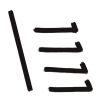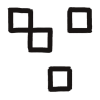Extended thoughts around the School
Martin Hargreaves
Some notes on the questions that we are asking ourselves.

Why is it a Choreographic School and not a School for Choreography?
We are not teaching choreography but collectively asking what happens when we form a community of artist researchers to think together about the choreographic  . One possible distinction between these terms is how choreography is often (but not exclusively) used to name the production of authored dance works, and how the choreographic
. One possible distinction between these terms is how choreography is often (but not exclusively) used to name the production of authored dance works, and how the choreographic  is used to name broader processes of thinking and working with systems, attitudes and dispositions towards the organisation of movement. The School
is used to name broader processes of thinking and working with systems, attitudes and dispositions towards the organisation of movement. The School is oriented towards the latter, towards enquiries into the emergence and operation of choreographic
is oriented towards the latter, towards enquiries into the emergence and operation of choreographic  practices, rather than towards the development of finished pieces of choreography.
practices, rather than towards the development of finished pieces of choreography.
This distinction between product and process, between dance pieces and other kinds of practices, is however perhaps impractical and unstable. If we put too much reliance on this opposition it will collapse and so it cannot be a foundational claim. Rather than begin by forcefully excluding choreographers, choreography, or the making of dance, we instead want to indicate that our attraction to the term the choreographic  arises from how it might be inclusive of all these things, thoughts and deeds through an openness of definition. The choreographic
arises from how it might be inclusive of all these things, thoughts and deeds through an openness of definition. The choreographic  can refer to choreography, and to the writing of dancing bodies, but it can also refer to modes of generating and circumscribing movement that don't register as dance, or as art works. We don’t fully know what it can gesture towards, what might properly or improperly fall within its sphere; we are keen to keep the choreographic
can refer to choreography, and to the writing of dancing bodies, but it can also refer to modes of generating and circumscribing movement that don't register as dance, or as art works. We don’t fully know what it can gesture towards, what might properly or improperly fall within its sphere; we are keen to keep the choreographic  as an open question for the School
as an open question for the School . The emphasis is on working together to choreograph a School, rather than operating as an institution that delivers a canonical curriculum of what choreography is. William Forsythe, one of the Artistic Faculty
. The emphasis is on working together to choreograph a School, rather than operating as an institution that delivers a canonical curriculum of what choreography is. William Forsythe, one of the Artistic Faculty  of the first cycle of the School
of the first cycle of the School , has written that choreography is “a curious and deceptive term. The word itself, like the processes it describes, is elusive, agile, and maddeningly unmanageable. To reduce choreography to a single definition is not to understand the most crucial of its mechanisms: to resist and reform previous conceptions of its definition.” (William Forsythe 2011, 90)
, has written that choreography is “a curious and deceptive term. The word itself, like the processes it describes, is elusive, agile, and maddeningly unmanageable. To reduce choreography to a single definition is not to understand the most crucial of its mechanisms: to resist and reform previous conceptions of its definition.” (William Forsythe 2011, 90)
We want to celebrate the elusiveness of the mechanisms that Forsythe identifies. In shifting towards the choreographic  , we are hoping to attract artists who might work in relation to choreography but may not always consider themselves as choreographers. There are histories of who has been able to, or wanted to, claim the title of choreographer and how that has constellated with authorship, ownership, genius and genre. The concept of the choreographic
, we are hoping to attract artists who might work in relation to choreography but may not always consider themselves as choreographers. There are histories of who has been able to, or wanted to, claim the title of choreographer and how that has constellated with authorship, ownership, genius and genre. The concept of the choreographic  acknowledges these but revises, refuses and extends beyond those canons and family trees.
acknowledges these but revises, refuses and extends beyond those canons and family trees.
"I imagine the work of the choreographic as one possibility of sensual address—a dialogic opening in which art not only is looked at but also looks back, igniting a tremulous hesitation in the ways that we experience and respond." (Jenn Joy 2014, 1)
Jenn Joy’s text The Choreographic (2014) identifies an artistic and theoretical turn from the idea of choreography as the creation of authored works to the concept of the choreographic  as an expansive mode of thinking and working with and through the relationship between bodies, movement, space, time, and perception. In the quote above she suggests that art is still one point of articulation for the choreographic
as an expansive mode of thinking and working with and through the relationship between bodies, movement, space, time, and perception. In the quote above she suggests that art is still one point of articulation for the choreographic  , and the potential for tremulous and sensual reciprocity is one of its main forces, but one of the ways the choreographic
, and the potential for tremulous and sensual reciprocity is one of its main forces, but one of the ways the choreographic  differs from conventional uses of the word choreography is in how it extends to include cultural, social, economic and political contexts that both enable and exceed what counts as art.
differs from conventional uses of the word choreography is in how it extends to include cultural, social, economic and political contexts that both enable and exceed what counts as art.
Bojana Cvejic’s text Choreographing Problems (2015) starts by problematising what the subject and object of choreography might be, tracking how many artists and theorists in recent decades no longer consider choreography as being solely concerning with human bodies and dancerly movement. She elaborates on this to suggest that choreography manifests through the posing of problems, invoking and engaging how bodies and movement are conceptualised and contextualised, and bound up in systems of thinking and practising. Cvejic’s emphasis on problems helps us suggest that research is always already underway in choreography. Not research that aims towards finding answers necessarily, but research that navigates the entanglement of moving bodies in multiple and conflicting organisational schema.
To think alongside these artists and writers, we frame the Choreographic School as a proposal of a relational problematising of what choreography has been and what it might become. We invite artists to spend time with their uncertainties around the choreographic  and to explore mechanisms of resistance and reformulation, of affect and sensuality, to occupy the spaces of tremulous hesitation.
and to explore mechanisms of resistance and reformulation, of affect and sensuality, to occupy the spaces of tremulous hesitation.
"An ethics of knowledge is the foundation of any school in its essential definition as a gathering place, but the complexity of what that knowledge should be, how its production is configured and unfolds, who translates it across the bridges of generations and time, whether its structure is rigid or limpid in its willingness to change, whether it is resistant to external mandates or longs for the imprimatur of an outside authority, and what status and success signify for its teachers and graduates - all of these define the place of gathering, its ethical complexion, its reasons for being, and what learning means there." (Steven Henry Madoff 2009, ix)
In this quote, Madoff introduces his edited anthology of writings Art School, Propositions for the 21st Century (2009), by situating the school as a concept and as a practice where ethical questions around knowledge generation and dissemination  are always staged. This is particularly the case when the subject and object of the education is art, as encounters with artistic practices already invoke relationships to technique and discipline, to skill and virtuosity, and to didactics and pedagogy
are always staged. This is particularly the case when the subject and object of the education is art, as encounters with artistic practices already invoke relationships to technique and discipline, to skill and virtuosity, and to didactics and pedagogy  . The art school has been a site throughout the 20th century where experiments with structures, systems and flows of knowledge have repeatedly been housed and reformulated. Madoff’s anthology makes the case that this is still an urgent question, particularly in the context of the increasing marketisation and exclusivity of formal arts education degrees. Sam Thorne makes a similar claim in his introduction to School: A recent history of self-organized art education (2017), a collection of interviews with artists and curators who have engaged in experimental pedagogic projects. He offers an overview of projects that have emerged since the 2000s as alternatives, oppositions, additions or reimaginations of how the school can resist reproducing student debt as a founding principle of education. He suggests that approaches to pedagogy
. The art school has been a site throughout the 20th century where experiments with structures, systems and flows of knowledge have repeatedly been housed and reformulated. Madoff’s anthology makes the case that this is still an urgent question, particularly in the context of the increasing marketisation and exclusivity of formal arts education degrees. Sam Thorne makes a similar claim in his introduction to School: A recent history of self-organized art education (2017), a collection of interviews with artists and curators who have engaged in experimental pedagogic projects. He offers an overview of projects that have emerged since the 2000s as alternatives, oppositions, additions or reimaginations of how the school can resist reproducing student debt as a founding principle of education. He suggests that approaches to pedagogy  across these experimental projects are based less on reproducing formal systems of education and more on the collaborative and discursive conditions of learning; “they are about change through experience, a type of process”, (Sam Thorne 2017, 48). We want to draw on these histories of experimental artistic pedagogy
across these experimental projects are based less on reproducing formal systems of education and more on the collaborative and discursive conditions of learning; “they are about change through experience, a type of process”, (Sam Thorne 2017, 48). We want to draw on these histories of experimental artistic pedagogy  as an ongoing practice of generating and sharing knowledge. Put simply, the choreographic
as an ongoing practice of generating and sharing knowledge. Put simply, the choreographic  isn’t only the object of our research it is also the means by which we want to question the movements of how we gather to learn from each other.
isn’t only the object of our research it is also the means by which we want to question the movements of how we gather to learn from each other.
In a recent interview, artist Dora Garcia expresses a hope that art education can engage in “nonhierarchical, equal, critical, self-critical, and alert pedagogy, one that is very much conscious of questions of class, Eurocentrism, and, again, privilege in its many different forms and the exclusions they might generate” (Dora Garcia 2023). This is also a hope for the School - that we can learn from many different experiments in education to create a space for choreographic researchers to teach and learn critically. We understand the pedagogic environment to be choreographed in real time by all the artists who are moving through it. The faculty
- that we can learn from many different experiments in education to create a space for choreographic researchers to teach and learn critically. We understand the pedagogic environment to be choreographed in real time by all the artists who are moving through it. The faculty  , the freelancers and all the other staff at Sadler’s Wells that we work alongside will contribute to the question of how to shape a school. There is no curriculum other than the discourse that emerges and shapes how we work, think, move, and make together. One way to articulate this approach to education is through the postdisciplinary
, the freelancers and all the other staff at Sadler’s Wells that we work alongside will contribute to the question of how to shape a school. There is no curriculum other than the discourse that emerges and shapes how we work, think, move, and make together. One way to articulate this approach to education is through the postdisciplinary .
.
Postdisciplinarity is not a wholesale rejection of disciplines and specific genealogies of practices but a celebration of the excesses and spillages of knowledge that are unconstrained by convention and tradition. The prefix of post- here is not to be understood as a temporal ordering. We are not coming after, or suggesting that we first need to establish discipline in order to supersede it. We are drawn to post- rather than inter-, intra-, or trans- disciplinary because it helps us propose that disciplines are always only contingent and fragile, and they are always moving towards dissolution and reimagination. Post-, in this case, also summons the idea of a horizon of address, a gesture towards something as yet undefined.
If we respond to Forsythe’s challenge, cited above, to think of choreography as always resistant and reforming then we are already engaged in an undoing and moulting of disciplinary boundaries. Not least through the necessity of rethinking/reconceiving terminologies used to describe how, what and why the choreographic  emerges and engages. This critical reflection is in dialogue with feminist, postcolonial and queer historiographies that ask how, and by who, concepts and practices are generated, valued, transmitted, regulated, and codified. In this context, Trajal Harrell, who is also a member of the Artistic Faculty
emerges and engages. This critical reflection is in dialogue with feminist, postcolonial and queer historiographies that ask how, and by who, concepts and practices are generated, valued, transmitted, regulated, and codified. In this context, Trajal Harrell, who is also a member of the Artistic Faculty  for this first cycle, has articulated how imagination and fabulation transgress and enact subversion to propose new spaces for critical working within and without disciplinary forms of knowledge:
for this first cycle, has articulated how imagination and fabulation transgress and enact subversion to propose new spaces for critical working within and without disciplinary forms of knowledge:
"There is a power – at least from a postcolonial feminist perspective – in history as an imaginative process. We cannot just think that historical lineage improves in a standard academic way as the only way. And that is a lot of what my work is about – this artistic space in which we can imagine history. And I think this has its power as well." (Trajal Harrell 2022)
As Harrell suggests, standardised academic lineages are a legacy of colonialism, requiring epistemological hierarchies which exclude bodily knowledge and reject living archival practices which do not submit to institutional extractivism and preservation. In response, many feminist, queer and postcolonial scholars, activists and artists have called for an imaginative postdisciplinary  approach that counters the violence of the traditional limiting and exclusionary boundaries between disciplines. This attitude exceeds and erodes traditional methods of making and understanding, and indeed insists on the questioning of what we might mean, and who we might exclude, when we name something as ‘traditional’.
approach that counters the violence of the traditional limiting and exclusionary boundaries between disciplines. This attitude exceeds and erodes traditional methods of making and understanding, and indeed insists on the questioning of what we might mean, and who we might exclude, when we name something as ‘traditional’.
This postdisciplinary  enquiry is reflected in our expanded use of the term choreographic
enquiry is reflected in our expanded use of the term choreographic  as a horizon of collective thinking, imagining and practising, rather than a singular
as a horizon of collective thinking, imagining and practising, rather than a singular  aesthetic, typology and social form. We want to work and improvise together to challenge the dominant Eurocentric narratives that have historically defined dance and movementand upheld normative ideals of ability, class, gender, race and sexuality. Through the artist research residencies that comprise the School
aesthetic, typology and social form. We want to work and improvise together to challenge the dominant Eurocentric narratives that have historically defined dance and movementand upheld normative ideals of ability, class, gender, race and sexuality. Through the artist research residencies that comprise the School we want to emphasise this, to support enquiry into what happens if we permit the concept of the choreographic
we want to emphasise this, to support enquiry into what happens if we permit the concept of the choreographic  to stray, trespass, drift, and welcome contamination. Our approach is to find paths away from known techniques of researching and making work, or to rewalk the old paths with a different gait. Alesandra Seutin, also an Artistic Faculty
to stray, trespass, drift, and welcome contamination. Our approach is to find paths away from known techniques of researching and making work, or to rewalk the old paths with a different gait. Alesandra Seutin, also an Artistic Faculty  member for this cycle, argues that pedagogy
member for this cycle, argues that pedagogy  should not about the acquisition of techniques to be displayed, as if embodied knowledge is property. She claims that “once you learn a technique you also need to learn how to unlearn it” (Alesandra Seutin 2021) As she proposes, there is a need to invest in cycles of learning-to-unlearn so that knowledges don’t become fixed in singular
should not about the acquisition of techniques to be displayed, as if embodied knowledge is property. She claims that “once you learn a technique you also need to learn how to unlearn it” (Alesandra Seutin 2021) As she proposes, there is a need to invest in cycles of learning-to-unlearn so that knowledges don’t become fixed in singular  modes of representation, but can also be used to reread the ambiguous past and face the undetermined future in the present moment of forming a School
modes of representation, but can also be used to reread the ambiguous past and face the undetermined future in the present moment of forming a School . Can we collectively and singularly follow dreams and desires to welcome the pleasures and risks of promiscuity, confabulation and uncertainty? Specialisation, expertise and focused research practices do not have to be rejected but we need to unlink them from gatekeeping, exclusion and ivory towers. Postdisciplinarity can give us the means to work in hybridisation, inhabit ambiguity, cause genre trouble and open to unanticipated encounters.
. Can we collectively and singularly follow dreams and desires to welcome the pleasures and risks of promiscuity, confabulation and uncertainty? Specialisation, expertise and focused research practices do not have to be rejected but we need to unlink them from gatekeeping, exclusion and ivory towers. Postdisciplinarity can give us the means to work in hybridisation, inhabit ambiguity, cause genre trouble and open to unanticipated encounters.
What is choreographic research  ?
?
We want artists to apply with their current concerns in choreographic research  . But what do we mean by that? We’ve outlined the choreographic
. But what do we mean by that? We’ve outlined the choreographic  about but what about research? What is research in the postdisciplinary
about but what about research? What is research in the postdisciplinary  context of the School
context of the School ? We are not asking artists to reframe their curiosity through standardised templates for research proposals. We are also not insisting on the imposition of academic languages to frame practical experimentation or on the need for artists to promise results and project the impact of their enquiries. We use this term research to invite artists to propose their own methods and practices for how to follow an itch, a desire, a problem, a hunch, an instinct, a question, an irritation, a doubt, a suspicion, a pull, a need. Research in this sense is the articulation, through whatever appropriate means and media, of a desire to stay with uncertainty, to pose problems without ready solutions, to ask questions that do not already anticipate answers.
? We are not asking artists to reframe their curiosity through standardised templates for research proposals. We are also not insisting on the imposition of academic languages to frame practical experimentation or on the need for artists to promise results and project the impact of their enquiries. We use this term research to invite artists to propose their own methods and practices for how to follow an itch, a desire, a problem, a hunch, an instinct, a question, an irritation, a doubt, a suspicion, a pull, a need. Research in this sense is the articulation, through whatever appropriate means and media, of a desire to stay with uncertainty, to pose problems without ready solutions, to ask questions that do not already anticipate answers.
We are not inviting research that is focused on a topic, theme, inspiration or story that choreography will then represent, or research into content that will form the basis of a dance piece. This is commonly how the terms “research and development” are coupled together in dance. We are inviting research into the choreographic  itself, because before we even get to the imagination of the outcome, we want to ask what is it to work choreographically. This may, or may not, involve a development stage, and it may lead to more questioning and more problems. An aim of the School
itself, because before we even get to the imagination of the outcome, we want to ask what is it to work choreographically. This may, or may not, involve a development stage, and it may lead to more questioning and more problems. An aim of the School is to find out how choreographic research
is to find out how choreographic research  can be articulated, singularly and collectively rather than stipulate how it might appear and be evidenced in outputs. We are interested in expanded horizons of choreographic
can be articulated, singularly and collectively rather than stipulate how it might appear and be evidenced in outputs. We are interested in expanded horizons of choreographic  thinking rather than setting down firm boundaries for what it might concern.
thinking rather than setting down firm boundaries for what it might concern.
One expanded horizon for research into the choreographic  could be this recurring insistence that we find between this term and the notions of the organisation of bodies and movement. If we accept this, then rather than answer the question of what the proper subject of choreography is, it raises more questions. We need to unpack these constitutive elements and ask what we mean by organisation, by bodies and by movement. We should be wary of anthropocentrism as much as possible and avoid assuming that it is only humans that organise the movement of theirs, and others, bodies. We are not proposing that choreography can only refer to specific formulations of the dynamics of human embodiment or only concern itself with movement through human spaces and timescales.
could be this recurring insistence that we find between this term and the notions of the organisation of bodies and movement. If we accept this, then rather than answer the question of what the proper subject of choreography is, it raises more questions. We need to unpack these constitutive elements and ask what we mean by organisation, by bodies and by movement. We should be wary of anthropocentrism as much as possible and avoid assuming that it is only humans that organise the movement of theirs, and others, bodies. We are not proposing that choreography can only refer to specific formulations of the dynamics of human embodiment or only concern itself with movement through human spaces and timescales.
William Forsythe's practice of Choreographic Objects asks if choreography might insist on the question of bodily knowledge production. Instead of thinking that the dancing human body is the only means by which choreography is enacted, he asks, “What else, besides the body, could physical thinking look like?” (Forsythe 2011, 91). What this question raises is that the choreographic  can, and already does, engage relations between human bodies within wider constellations of objects, non-human, more-than-human and posthuman bodies. This extends far beyond binaries of trained or untrained, amateur or professional to locate dancing as a possible action for all kinds of things, phenomena
can, and already does, engage relations between human bodies within wider constellations of objects, non-human, more-than-human and posthuman bodies. This extends far beyond binaries of trained or untrained, amateur or professional to locate dancing as a possible action for all kinds of things, phenomena  and events that may be said to be a body, have a body, embody, or disembody. In Alesandra Seutin’s work ‘Mimi’s Shebeen’ (2023) she extends the concept of a singular
and events that may be said to be a body, have a body, embody, or disembody. In Alesandra Seutin’s work ‘Mimi’s Shebeen’ (2023) she extends the concept of a singular  body to stage the body as a plural and contested site for community, for mourning, for resistance, for celebration. The shebeen, in apartheid era South Africa, was an illegal social space for Black activists to meet and Seutin claims it is also a body: “It's a space within a space within a space, an out of space-space, it's about empathy, empathising yourself into the life of the exiled” (Alesandra Seutin 2023). In an interview with Thomas F. DeFrantz, when asked about his thoughts on the body, Trajal Harrell responded that it's a disturbing question because it seems so simple. This question of the body raises the problem of how we might only focus on ideas of individualised and independent bodies, healthy and autonomous. His research into butoh has led him to think more about choreographies that are not concerned with heroic acts of self-discipline or mastery over movement. His focus is on “bodies which are dying, bodies which are feeble, bodies which are weak…so much of dance has been about strength and agility…there has to be a space for representing weakness… there has to be a place for the weak, and those who suffer, for those who are desperate and those who are miserable.” (Trajal Harrell 2021)
body to stage the body as a plural and contested site for community, for mourning, for resistance, for celebration. The shebeen, in apartheid era South Africa, was an illegal social space for Black activists to meet and Seutin claims it is also a body: “It's a space within a space within a space, an out of space-space, it's about empathy, empathising yourself into the life of the exiled” (Alesandra Seutin 2023). In an interview with Thomas F. DeFrantz, when asked about his thoughts on the body, Trajal Harrell responded that it's a disturbing question because it seems so simple. This question of the body raises the problem of how we might only focus on ideas of individualised and independent bodies, healthy and autonomous. His research into butoh has led him to think more about choreographies that are not concerned with heroic acts of self-discipline or mastery over movement. His focus is on “bodies which are dying, bodies which are feeble, bodies which are weak…so much of dance has been about strength and agility…there has to be a space for representing weakness… there has to be a place for the weak, and those who suffer, for those who are desperate and those who are miserable.” (Trajal Harrell 2021)
These provocations by our Artistic Faculty  are part of wider discussions concerning how we imagine and articulate what a moving body might do or might look like. Daisy Hildyard’s book The Second Body (2017) suggests that the motions of human bodies are always enabled by, and implicated in, larger scales of movement that are difficult to conceptualise or to see. Hildyard argues that any attempt to imagine and inhabit an individualised human body will summon another body, the global body that networks and sustains any attempt at individualisation. Embodiment always entails the atmospheric exchange of gases, the currents of oceans, the movement of capital, the melting of permafrost, the accumulation of plastics and the mass extinction event that is reconfiguring ecosystems at an increasing speed.
are part of wider discussions concerning how we imagine and articulate what a moving body might do or might look like. Daisy Hildyard’s book The Second Body (2017) suggests that the motions of human bodies are always enabled by, and implicated in, larger scales of movement that are difficult to conceptualise or to see. Hildyard argues that any attempt to imagine and inhabit an individualised human body will summon another body, the global body that networks and sustains any attempt at individualisation. Embodiment always entails the atmospheric exchange of gases, the currents of oceans, the movement of capital, the melting of permafrost, the accumulation of plastics and the mass extinction event that is reconfiguring ecosystems at an increasing speed.
"When we look at the global body, it is impossible to relate that body to anything individual because there can be no certain borders between one thing and another. We do not know what is relevant to the individual body, and what is outside it, because the atmosphere and the individual body are inside one another. Therefore, we cannot help seeing every individual as a part of the whole world: the whole of life becomes a mass and it becomes impossible to differentiate one thing from another... this global body, which is entirely without boundaries, doesn’t understand that individuals exist at all." (Daisy Hildyard 2017, 39-40)
Hildyard’s point is not that we should never attempt differentiation, or insist on individual boundaries, but rather that we should understand these actions as temporary and contingent strategies rather than ontological claims. Denise Ferreria da Silva makes a similar claim for thinking through singularity, rather than individuality, as a means to articulate specificities within larger plural entanglements. Drawing on a decolonial and anti-racist reading of both Western philosophical traditions and of quantum physics, she poses a problem that, for us, is at the centre of choreographic research  – what do we do when we attempt to isolate bodies and forces and rework them whilst simultaneously acknowledging that they are enmeshed in much larger ecological choreographies?
– what do we do when we attempt to isolate bodies and forces and rework them whilst simultaneously acknowledging that they are enmeshed in much larger ecological choreographies?
"What if, instead of the Ordered World, we imaged each existant (human and more-than-human) not as separate forms relating through the mediation of forces, but rather as singular expressions of each and every other existant as well as of the entangled whole in/as which they exist?" (Denise Ferreira da Silva 2016, p63). So if choreographic research  , broadly speaking, takes up these problems of when and how we might articulate singular
, broadly speaking, takes up these problems of when and how we might articulate singular  bodies in motion through time and space, we always have to keep open the questions: which bodies, what mobility, and whose time and space?
bodies in motion through time and space, we always have to keep open the questions: which bodies, what mobility, and whose time and space?
Bibliography
Cvejic, Bojana. 2015. Choreographing Problems: Expressive Concepts in Contemporary Dance and Performance. London: Palgrave Macmillan.
Forysthe, William. 2011. “Choreographic Objects”. In William Forsythe and the Practice of Choreography, edited by Steven Spier, 90-92. London: Routledge
Garcia, Dora. 2023. https://www.e-flux.com/education/features/528657/survey-dora-garca
Harrell, Trajal. 2021. https://phaidra.cab.unipd.it/o:460188
Harrell, Trajal. 2022. https://pw-magazine.com/2022/trajal-harrell-imaginative-proposition
Joy, Jenn. 2014. The Choreographic. Cambridge MA: MIT Press.
Hildyard, Daisy. 2017. The Second Body. London: Fitzcarraldo Editions
Madoff, Steven Henry (ed.). 2009. Art School: Propositions for the 21st Century. Cambridge MA: MIT Press.
Seutin, Alesandra. 2021. https://danceartjournal.com/2021/11/01/dance-techniques-are-tools-for-movement-not-dance-itself-alesandra-seutin-interview/
Seutin, Alesandra. 2023. https://www.kvs.be/en/pQMMzh7/interview-with-alesandra-seutin
da Silva, Denise Ferreira. 2016. “On difference without separability”. In J. Volz, & J. Rebouças (Eds.), 32nd bienal de Sao Paulo: Incerteza Viva (pp. 57–65). Sao Paulo: Fundaçao Bienal de Sao Paulo.
Thorne, Sam. 2017. School: A Recent History of Self-Organized Art Education. Berlin: Sternberg Press